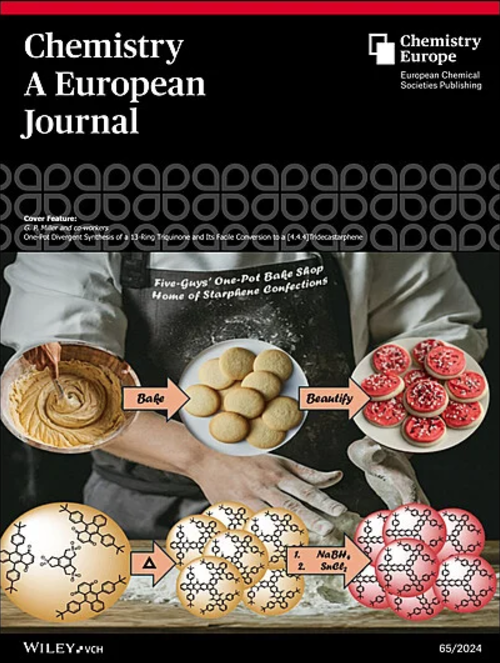Cover Feature: Towards White Light Emission Through Metal-to-Metal Charge Transfer (MMCT) Effect in Bi3+ Activated Ca2YTi2-mZrmGa3O12 (0≤m≤2) Garnets (Chem. Eur. J. 17/2025)
IF 3.9
2区 化学
Q2 CHEMISTRY, MULTIDISCIPLINARY
引用次数: 0
Abstract
The emission behaviour of Bi3+ was explored in two different hosts, Ca2YTi2Ga3O12 (CYT:Bi) and Ca2YZr2Ga3O12: Bi3+ (CYTZ:Bi). A broad emission in the yellow–orange region in the former with a maximum at 552 nm was attributed to Bi3+–Ti4+ MMCT transitions. In the latter, the Bi3+ ions were found to emit in the violet region (λem=395 nm) due to the 3P0,1→1S0 transition. After suitable modification, the compounds CYT:Bi and CYTZ:Bi emit white light. More information can be found in the Research Article by P. Thilagar, S. Natarajan and co-workers (DOI: 10.1002/chem.202404016).

求助全文
约1分钟内获得全文
求助全文
来源期刊

Chemistry - A European Journal
化学-化学综合
CiteScore
7.90
自引率
4.70%
发文量
1808
审稿时长
1.8 months
期刊介绍:
Chemistry—A European Journal is a truly international journal with top quality contributions (2018 ISI Impact Factor: 5.16). It publishes a wide range of outstanding Reviews, Minireviews, Concepts, Full Papers, and Communications from all areas of chemistry and related fields.
Based in Europe Chemistry—A European Journal provides an excellent platform for increasing the visibility of European chemistry as well as for featuring the best research from authors from around the world.
All manuscripts are peer-reviewed, and electronic processing ensures accurate reproduction of text and data, plus short publication times.
The Concepts section provides nonspecialist readers with a useful conceptual guide to unfamiliar areas and experts with new angles on familiar problems.
Chemistry—A European Journal is published on behalf of ChemPubSoc Europe, a group of 16 national chemical societies from within Europe, and supported by the Asian Chemical Editorial Societies. The ChemPubSoc Europe family comprises: Angewandte Chemie, Chemistry—A European Journal, European Journal of Organic Chemistry, European Journal of Inorganic Chemistry, ChemPhysChem, ChemBioChem, ChemMedChem, ChemCatChem, ChemSusChem, ChemPlusChem, ChemElectroChem, and ChemistryOpen.
 求助内容:
求助内容: 应助结果提醒方式:
应助结果提醒方式:


